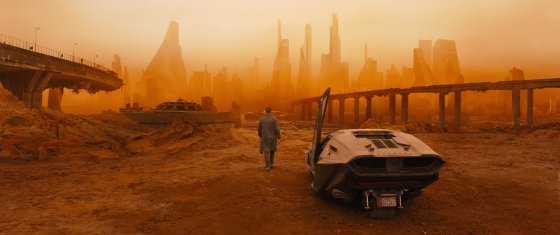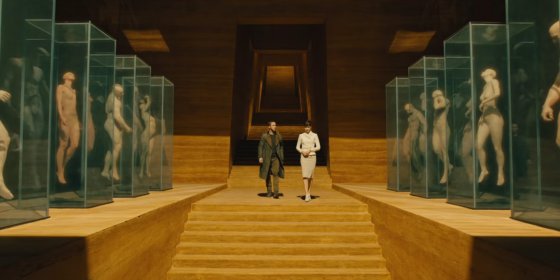Blade Runner 2049 : Review
 [Note: Director Denis Villeneuve has requested all reviews to be as nonspecific as possible and not to spoil any of the surprises which lie within Blade Runner 2049. We have included no specific plot points or spoilers. Hell, we don’t even mention Harrison Ford in this review.]
[Note: Director Denis Villeneuve has requested all reviews to be as nonspecific as possible and not to spoil any of the surprises which lie within Blade Runner 2049. We have included no specific plot points or spoilers. Hell, we don’t even mention Harrison Ford in this review.]
 1982’s Blade Runner was, in retrospect, an arthouse science-fiction film with the gall to masquerade as a mainstream action movie. It was a film which attacked from so many different fronts – wild prognostications of the future, social commentary on the state of humanity, big business versus the common man, all coupled with Syd Mead’s genius futurist design – and director Ridley Scott managed to slip this masterpiece straight into movie theaters across the world. Not only did it pervade cinema history with its unique vision, the film’s language and notions became part of a world lexicon.
1982’s Blade Runner was, in retrospect, an arthouse science-fiction film with the gall to masquerade as a mainstream action movie. It was a film which attacked from so many different fronts – wild prognostications of the future, social commentary on the state of humanity, big business versus the common man, all coupled with Syd Mead’s genius futurist design – and director Ridley Scott managed to slip this masterpiece straight into movie theaters across the world. Not only did it pervade cinema history with its unique vision, the film’s language and notions became part of a world lexicon.
 So how, after thirty-five years, have we been blessed with Blade Runner 2049? By being what its predecessor dared to be – an arthouse film with a grand vision and large amounts of heart and soul. It not only expands on the original’s themes of humanity and self, the film forges its own path, projecting a striking view into what could be our own future, a desolate wasteland to be ruled by the monied and picked apart by the vultures.
So how, after thirty-five years, have we been blessed with Blade Runner 2049? By being what its predecessor dared to be – an arthouse film with a grand vision and large amounts of heart and soul. It not only expands on the original’s themes of humanity and self, the film forges its own path, projecting a striking view into what could be our own future, a desolate wasteland to be ruled by the monied and picked apart by the vultures.
 Assuming the directorial reins is acclaimed auteur Denis Villeneuve, who takes the elegance of last year’s surprise sci-fi think piece Arrival and uses it to further the Blade Runner mythos. In the hands of any other director, Blade Runner 2049 would have wound up a cheap imitation of the original, content to conform to studio notes and molding it to fit an easily-palatable, mass-market formula. Villeneuve has never been one to go the easy way, and he thankfully doesn’t take the opportunity to start now.
Assuming the directorial reins is acclaimed auteur Denis Villeneuve, who takes the elegance of last year’s surprise sci-fi think piece Arrival and uses it to further the Blade Runner mythos. In the hands of any other director, Blade Runner 2049 would have wound up a cheap imitation of the original, content to conform to studio notes and molding it to fit an easily-palatable, mass-market formula. Villeneuve has never been one to go the easy way, and he thankfully doesn’t take the opportunity to start now.
 Villeneuve uses every bit of the film’s 163 minutes to immerse us in the barren landscape of future Los Angeles, sacrificing none of his artistic intent for the sake of more showings at the local multiplex. Saturated color palettes and careful staging define the various locations in which LAPD Officer K (Ryan Gosling) finds himself mired in what may be the greatest mystery of his life, not to mention one of the most shattering revelations known to mankind.
Villeneuve uses every bit of the film’s 163 minutes to immerse us in the barren landscape of future Los Angeles, sacrificing none of his artistic intent for the sake of more showings at the local multiplex. Saturated color palettes and careful staging define the various locations in which LAPD Officer K (Ryan Gosling) finds himself mired in what may be the greatest mystery of his life, not to mention one of the most shattering revelations known to mankind.
 K is our avatar in the game that is Blade Runner 2049; long, dreamlike takes keep us right alongside him as he uncovers, bit by bit, a secret which could change the course of life as we know it. Renowned cinematographer Roger Deakins often composes his frames to dwarf K against the stifling confines of the dark alleys of Los Angeles or the sandstorm-ravaged expanse of Las Vegas to highlight his isolation. K isn’t just a police officer; he’s one of the last Blade Runners, charged with hunting and “retiring” (read: executing) Replicants, outlawed synthetic humans once used as slave labor for the Off-World colonies.
K is our avatar in the game that is Blade Runner 2049; long, dreamlike takes keep us right alongside him as he uncovers, bit by bit, a secret which could change the course of life as we know it. Renowned cinematographer Roger Deakins often composes his frames to dwarf K against the stifling confines of the dark alleys of Los Angeles or the sandstorm-ravaged expanse of Las Vegas to highlight his isolation. K isn’t just a police officer; he’s one of the last Blade Runners, charged with hunting and “retiring” (read: executing) Replicants, outlawed synthetic humans once used as slave labor for the Off-World colonies.
 As the anchor and beating heart of Blade Runner 2049, Gosling doesn’t have an easy time. He’s forced to give K a detachment necessary for his job, but he’s also tasked with carrying the film’s emotional, humanist weight in a world which isn’t kind to humans. The climate is torn asunder, cities are laid waste, the skies are toxic, and people live in relative squalor, with habitats and offices being built upward to accommodate the crush of overpopulation. Throughout all of this, Gosling gives one of his best performances, taking us through the joys of love, the pains of his occupation, and the horrors of the discoveries which loom like oncoming storms in his eyes.
As the anchor and beating heart of Blade Runner 2049, Gosling doesn’t have an easy time. He’s forced to give K a detachment necessary for his job, but he’s also tasked with carrying the film’s emotional, humanist weight in a world which isn’t kind to humans. The climate is torn asunder, cities are laid waste, the skies are toxic, and people live in relative squalor, with habitats and offices being built upward to accommodate the crush of overpopulation. Throughout all of this, Gosling gives one of his best performances, taking us through the joys of love, the pains of his occupation, and the horrors of the discoveries which loom like oncoming storms in his eyes.
 Of course, the only opulence present in this apocalyptic nightmare is found belonging to Niander Wallace (Jared Leto), a businessman intent on pushing human life to the side with wave after wave of his own brand of Replicants. The symbolism of the film equating corporations to people stings a bit when viewed with eyes directed toward today’s sociopolitical divide. Fittingly, Wallace is also portrayed as blind, driving the metaphor home with a sledgehammer.
Of course, the only opulence present in this apocalyptic nightmare is found belonging to Niander Wallace (Jared Leto), a businessman intent on pushing human life to the side with wave after wave of his own brand of Replicants. The symbolism of the film equating corporations to people stings a bit when viewed with eyes directed toward today’s sociopolitical divide. Fittingly, Wallace is also portrayed as blind, driving the metaphor home with a sledgehammer.
 Blade Runner 2049 is pure visual poetry told at a languid pace and executed with just as much care. When viewing the film, you can almost feel the respect and love for the original which Villeneuve seems to have carried like a totem every day on the set. Every shot is composed with passion, every edit cut with grace, every word spoken with clarity and meaning. This is not so much a sequel as it is an entirely new enterprise with one of today’s most electrifying and thoughtful directors at the helm.
Blade Runner 2049 is pure visual poetry told at a languid pace and executed with just as much care. When viewing the film, you can almost feel the respect and love for the original which Villeneuve seems to have carried like a totem every day on the set. Every shot is composed with passion, every edit cut with grace, every word spoken with clarity and meaning. This is not so much a sequel as it is an entirely new enterprise with one of today’s most electrifying and thoughtful directors at the helm.
 And that’s exactly what a new Blade Runner story and movie needs: thoughtfulness. It wasn’t a throwaway film in 1982, and it remains a vital, visceral part of our cinematic consciousness now. Villeneuve demonstrates, in no uncertain terms, that Blade Runner 2049 is not an unneeded afterthought of a sequel. It’s timely in its thematic material and arresting in its uncompromising vision, resulting in one of the most artistically vivid films in history.
And that’s exactly what a new Blade Runner story and movie needs: thoughtfulness. It wasn’t a throwaway film in 1982, and it remains a vital, visceral part of our cinematic consciousness now. Villeneuve demonstrates, in no uncertain terms, that Blade Runner 2049 is not an unneeded afterthought of a sequel. It’s timely in its thematic material and arresting in its uncompromising vision, resulting in one of the most artistically vivid films in history.
In theaters October 6, 2017.
MPAA Rating: R for violence, some nudity, sexuality, and language.
Running time: 163 minutes.
Blade Runner 2049 (2017)
Rating
5
Blade Runner 2049 is pure visual poetry, timely in its thematic material and arresting in its uncompromising vision, resulting in one of the most artistically vivid films in history.










